<< New
Q&A More Q&A, part 10 >>
Part 9 >> Part 8 >>
Part 7 >> Part 6 >>
Part 5 >> Part 4
>> Part 3 >> Part
2 >> Part 1 >> Gunwriters guns.connect.fi
Link page

Custom Search
Latest update 10.03.2001
G.O.W. Kickback:
Questions and Answers, Part 11
Answered by: P. T. Kekkonen
Information Wanted
HUSQVARNA/BASTMAN rifle
I am looking for any information I can find on the man whose name is engraved into the
barrel of the Husqvarna Model 35 I just bought. The company tells me it was made around
1930, and that GEORG A. BASTMAN, whose name is engraved on it, was the proprietor
of a famous gunshop in Stockholm that no longer exists.
It has an octagonal barrel and three leaf sights, not the two shown in the illustration we
found on the Web. Do you know if he made this one, or had it made for him, or what his
name on it means? Does any literature exist on the man's work? Do you know how many of
these were made? It is quite accurate, and the workmanship is beautiful. It's in very good
shape. Naturally, if you have any idea of its value, we would listen with both ears!
A.R. Texas, USA.
I have
not literature about Husqvarna firearms easily available
here and now. The only book I know is "HUSQVARNA HAGELVAPEN" about shotguns and
some combination guns made by Vapenfabrik Husqvarna. We have, however, some visitors in
Sweden, who are presumably able and willing to help us, I hope so. Next lines for them are
written in Swedish:
*************************************************************
GIV AKT, visitörerna i Sverige: Om ni har kännedom av Georg
A.Bastman i Stockholm och Husqvarna gevär modell 35, var så god, omtala det till
GOW. Kännedom även på Svenska är välkommen. Jag kan översätta Svenska till
Engelskan med allra lätthet.
*************************************************************
I have not yet idea of your rifle's value, because you didn't tell it's kind of action and
it's caliber: "We cannot give any diagnosis without sufficient anamnesis".
0703 MMI; PT
GASSER-made "De Luxe" rifle
I have come across a rifle made by Gasser, but I cannot find any information on the rifle.
It looks to be written in German as follows: "Ralf Hofner or Hafner - Koniglicher
Hofbuchsenmacher - Gasser". It has a double trigger, single shot and a lot of scrolls
designs on the chamber, and it has a octagon barrel. I hope that you can help me with some
information on this or direct me to someone that does.
F.P.
My
available literature is, unfortunately, unable to tell anything about "Royal Court
Gunsmith RALF HOFNER or HAFNER". Firm GASSER was Austrian manufacture of firearms,
especially revolvers, since licensed copies of British BEAUMONT-ADAMS handguns in 1862
until 1st World War, when demand of the army revolvers was faded due to general adoptment
of the selfloading pistols. Gasser was in the business until 1918. Once upon a time
produced Gasser 100 000 revolvers per annum for Austro-Hungarian armed forces and police
plus for export especially to Montenegrian kingdom.
King NIKITA of Montenegro was a stockholder of Gasser plant. He gave a legendary Royal
Dictate: "Every full-grown male citizen in Montenegrian Kingdom is not only justified
but also obliged to own at least one 11 mm Montenegrian Gasser revolver!" While
empire of Austro-Hungary was reigned over Austrian emperor FRANZ JOSEPH (since 1848 until
1916), Hungary was still a semi-independent kingdom, and independent kingdom since 1916
until 1918. Monarch over Hungary was a king KAROLY IV. I think that your rifle is made
durig his short era of administration, if it is a breechloader. It is a high-priced
collector's item, of course! Not so many gunsmiths were "Königlicher
Hofbüschenmachers" in this era, and fading Gasser was constrained to yeild all the
firearms ordered from them, also exclusive models designed by individual gunsmiths.
0603 MMI; PT
Shooting experiences with Swedish Suomi Gun
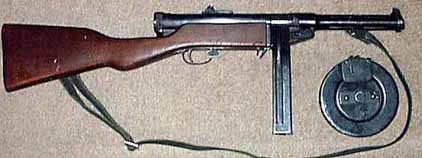 I forgot to mention that I have reactivated a Swedish M37-39 that was cut to pieces by some
unreasonable cur. The barrel length is much shorter than the Finnish
version and the sights are different but the operation seems the same. Using Israeli
surplus and British WWII surplus ammunition the gun was timed at 1007 RPM but it should be
noted that this ammunition increases the rate of fire in any SMG I have used it in.
I forgot to mention that I have reactivated a Swedish M37-39 that was cut to pieces by some
unreasonable cur. The barrel length is much shorter than the Finnish
version and the sights are different but the operation seems the same. Using Israeli
surplus and British WWII surplus ammunition the gun was timed at 1007 RPM but it should be
noted that this ammunition increases the rate of fire in any SMG I have used it in.
Surplus Finnish ammunition (SAKO I think) resulted in a more reasonable rate of 825 rpm
avg. The gun works quite well and the only problems we had with it were related to the
ammo and 1 of the drum mags I was using. It tended to feed poorly when getting low on ammo
so I suppose I need to increase spring tension. The Swedish 50rd coffin mags worked quite
well loaded with 45 rds and were not too bad to load with the supplied loader.
Thanks for the great website. It helped a lot in this project.
Frank
Comments:
Barrel and jacket of Swedish-made SUOMI submachine gun M37-39 are not
"sawed-off" afterwards, but made shorter in factory. Israeli and British
ammunition are presumably loaded for submachine gun use. (If the headstamp of British
cartridges is "9 MM" with black number and capital letters, they are actually
loaded in Canada: Very strong medicine, able to ruin some weak handguns like Luger P-08).
Finnish surplus cartridges with headstamp "SO" are presumably loaded for
handguns like P-08 and Lahti L-35 with usual 9 x 19 mm powder charges. That's why the
lower firing rate.
1000+ rpm seems to be unusually high rate even when the submachine gun loads are used.
Have you examined, whether the vacuum valve in breech-cap of your gun works? It's spring
may be weakened, or removed by some cur. There may be also some dirt in the valve
preventing proper functioning of it. A "phonograph spring" of your troublesome
drum magazine may be weakened by age or improper disassembly & re-assembly of
magazine. It is not difficult to increase it's tension if you are able to disassembly the
magazine, but don't overdo this action! Otherwise you cannot load the magazine to it's
full capacity. (Actually it is advisable to load old 70 rds drum with fifty rounds only,
or just 35 rds, filling the inner feed groove only. Spare feed spring may be hard to find
nowadays if you manage to break it).
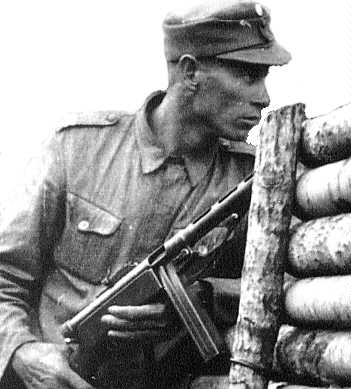 The coffin
magazine is advisable to load with no more than 40 rounds. I loaded it just with 30 rounds
with my "do-it-yourself" filler device, made from a screwdriver. I've shot ca.
3000 cartridges from a coffin without any feed jams, but I was ground and polished all the
burrs away from the lips of my magazine. (A routine, needed for all mass-produced clips or
magazines, but again I must warn: Don't overdo it!). Also I took care that the feed
springs were assembled correctly: Left one to left side of a partition and right one to
right side. Unless essential, do not detach the springs from the zinc-alloy magazine
followers.
The coffin
magazine is advisable to load with no more than 40 rounds. I loaded it just with 30 rounds
with my "do-it-yourself" filler device, made from a screwdriver. I've shot ca.
3000 cartridges from a coffin without any feed jams, but I was ground and polished all the
burrs away from the lips of my magazine. (A routine, needed for all mass-produced clips or
magazines, but again I must warn: Don't overdo it!). Also I took care that the feed
springs were assembled correctly: Left one to left side of a partition and right one to
right side. Unless essential, do not detach the springs from the zinc-alloy magazine
followers.
A MANNEQUIN OF TIKKAKOSKI Oy
Famous Finnish hero of wars 1939 - 1944, VILJAM PYLKAS (1912 - 1999) with a
KP/31. Note a coffin magazine. Name "ANTTI ROKKA" was given to him by
writer VAINO LINNA, author of novel "TUNTEMATON SOTILAS"/
"THE UNKNOWN SOLDIER", published in 1954, and the "SOTAROMAANI"/
"A WAR NOVEL" (actually an uncensored version of "Tuntematon
Sotilas"), published in 2000. V. Pylkas introduced himself as: "A farmer from
Carelian Isthmus. Nowadays a mannequin of Tikkakoski". A book "Tuntematon ROKKA" by Petri Sarjanen is published in
2000. Not yet translated to English. "The Unknown Soldier" (censored
version) was published in English sometimes in 1950s or '60s. It has been out of print
more than four decades ago.
My opinion is that not the faults of design but unskilled use was a reason why the coffin
magazine was abandoned in Finland. Some feed springs, imported from Sweden, were also of
poor quality, presumably as consequence of sabotage or carelessness of tempering. There
were "commies" also in Sweden during Third Finnish Independence Struggle
1941 - 44.
2802 MMI; PT
New Birth of L-39
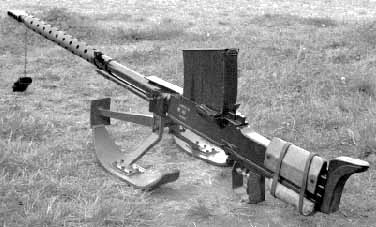 Hi PT, its been a while but progress is being made on the
reactivation of my L39. My original plan of sleeving the chamber
was shot down by a friend who asked some rather good questions. The Chamber walls end up
being too thin to support the sleeve properly and filling of the drilled holes is not
reasonable without welding. I did not want to heat the barrel like that as it would create
hard spots in the metal that might lead to fractures. The end result is that I wrote a CNC
program to make an entirely new chamber section 241mm long . The barrel is cut down in
diameter and threaded into this piece and the chamber is polished to blend and finish it.
It sound pretty simple but the measurements are difficult as the 3 barrels I have had
access to are all different external dimensions.
Hi PT, its been a while but progress is being made on the
reactivation of my L39. My original plan of sleeving the chamber
was shot down by a friend who asked some rather good questions. The Chamber walls end up
being too thin to support the sleeve properly and filling of the drilled holes is not
reasonable without welding. I did not want to heat the barrel like that as it would create
hard spots in the metal that might lead to fractures. The end result is that I wrote a CNC
program to make an entirely new chamber section 241mm long . The barrel is cut down in
diameter and threaded into this piece and the chamber is polished to blend and finish it.
It sound pretty simple but the measurements are difficult as the 3 barrels I have had
access to are all different external dimensions.
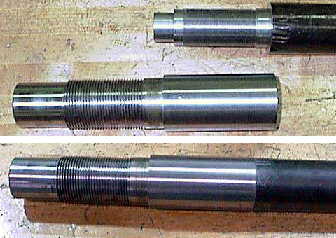 The first barrel is assembled and I need only to
finish the chamber so that it can be installed. Then the extractor groove can be located
as well as the anti-rotation screw hole. My barrel is next. I am putting together a
package of drawings to send to you that shows in more detail what I am talking about. I
feel that this will be the safest way to get the old beast roaring again. I think when you
see the drawings you will agree that this should be about as strong as the original setup.
Steel used is 4140 normalized, I checked the Rockwell hardness of it and the original
barrel and they are close. My piece is 28 on the Rockwell C scale and the original is 24.
The first barrel is assembled and I need only to
finish the chamber so that it can be installed. Then the extractor groove can be located
as well as the anti-rotation screw hole. My barrel is next. I am putting together a
package of drawings to send to you that shows in more detail what I am talking about. I
feel that this will be the safest way to get the old beast roaring again. I think when you
see the drawings you will agree that this should be about as strong as the original setup.
Steel used is 4140 normalized, I checked the Rockwell hardness of it and the original
barrel and they are close. My piece is 28 on the Rockwell C scale and the original is 24.
The 28 reading indicates that my piece has a tensile strength of approximately 135,000psi
( 9500kgf/cm) and yield of 112,000psi (7875kgf/cm) I have now a loading press to finally
load my brass with. The loading that most of the shooters I know are using is 35.6gram
(550grains) of Winchester WC872 with one of my 154 grm brass bore-rider bullets. I have
loaded a small number already with a somewhat lighter bullet to test fire initially.
Bullets are 89 gram US 20mm projectiles with the driving band turned down slightly. Powder
charge is the same 35.6 gram. I was told by the veteran shooters that this charge with the
light bullet will give a bit of a muzzle flash but loading any less powder is asking for
trouble. The space in the cartridge is taken up by a piece of tissue and a styrofoam
packing peanuts. Both loadings have been fired and the brass does not show any signs of
overpressure. Does all this sound reasonable?
Things are going and I am anxious to get out and send some heavy metal downrange....
Frank
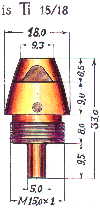 Yes, all this sounds reasonable. I have just finished an article
about 20 x 138 mm special loads of L-39 for GOW/ Finnish site, including all available
information about projectile weights, velocities, penetrations of Italian (BREDA Model
1935) and Finnish (VKT) AP projectiles, filling charges of Finnish high-explosive (TNT)
and incendiary (White Phosphorus) shells, sensitive and sensitive/retarded
point-detonating fuzes of those shells
Yes, all this sounds reasonable. I have just finished an article
about 20 x 138 mm special loads of L-39 for GOW/ Finnish site, including all available
information about projectile weights, velocities, penetrations of Italian (BREDA Model
1935) and Finnish (VKT) AP projectiles, filling charges of Finnish high-explosive (TNT)
and incendiary (White Phosphorus) shells, sensitive and sensitive/retarded
point-detonating fuzes of those shells 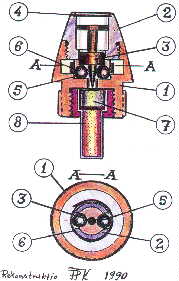 (Ti - 15/18) with
usual and improved German DUPLEX detonators. Also there are listed powder charges of these
cartridges plus (NOTA BENE!) the initiative charges of blackpowder or blank cartridge
powder in the small silk bags behind the main charges.
(Ti - 15/18) with
usual and improved German DUPLEX detonators. Also there are listed powder charges of these
cartridges plus (NOTA BENE!) the initiative charges of blackpowder or blank cartridge
powder in the small silk bags behind the main charges.
It was a rule rather than exception to use a "duplex charge" in 20 x 138 mm
Solothurn Long cartridges. Usual main charge was ca. 38 to 43 grams of "coarse"
single-base powder and half gram of fine blackpowder as an initiative charge in Italian or
German cartridges and 0.30 gram of PaPP (today N310) powder in Finnish cartridges. Your
cartridges with 89 grams shells seems to need some "booster" between the primer
and main charge because of it's light projectile. Weight of lightest Finnish shell
(high-explosive; TNT-filled; with an aluminium-body fuze) was 117 grams.
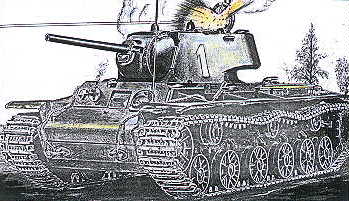 Powder charge was 43 grams + 0.30 gram of PaPP as an
initiative charge. I presume, you may use some 0.40 gram of HODGDON HP-38 as a booster,
bagged into small cotton-gauze bag and rammed into bottom of the case. With this booster
you may reduce the main charge to 30 grams without risk of detonation. Most heavy Finnish
VKT AP "blue bullet" (without a tracer) had weight 150 grams. Main charge was
40.7 grams and weight of initiative charge was 0.30 gram of PaPP powder.
Powder charge was 43 grams + 0.30 gram of PaPP as an
initiative charge. I presume, you may use some 0.40 gram of HODGDON HP-38 as a booster,
bagged into small cotton-gauze bag and rammed into bottom of the case. With this booster
you may reduce the main charge to 30 grams without risk of detonation. Most heavy Finnish
VKT AP "blue bullet" (without a tracer) had weight 150 grams. Main charge was
40.7 grams and weight of initiative charge was 0.30 gram of PaPP powder.
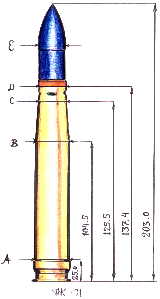
Your brass bullet is somewhat heavier. So your main charge 35.6 grams may be OK, but if
you note signs of incomplete burning of powder (excessive muzzle flash; unburned kernels
in the bore; "sluggish" autoloading; hangfires), you may use an initiative
charge without any hazard, let's say 0.30 gram of bagged HP-38 in your cartridges.
Blackpowder booster charges are not recommended for firearms with a gas piston action.
Germans preferred blackpowder initiative charges, but they had machine cannons and
Solothurn anti-tank rifles, all with short-recoil actions.
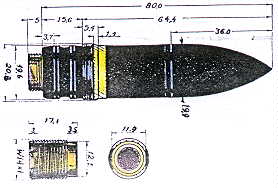
Italian AP bullet with a tracer. Originally designed for 20 mm BREDA machine cannon but
fit for L-39 too. Suitable for shooting down Russian armored IL-2 aeroplanes, due to the
incendiary effect of a broad tracer flame and sufficient armor penetration. Color code:
Bullet painted black. Yellow ribbon denotes existence of a tracer, burning to 2.5
kilometers horizontal range. Muzzle velocity was 850 meters per second. Projectile weight
147 grams.
I'll try to translate my article about special loads of L-39 to English when I'll get some
spare time. Finnish officials and "Association of Responsible Importers and Dealers
of Sport & Hunting Firearms" are (once again) trying to suppress our GOW/Finnish
site. If they'll manage this time to blackout the screens in Finland, I have more time to
create articles for GOW/Universal site and offer more "private only" information
service to our Privileged Visitors. Nowadays is 50 % of information E-mailed to individual
visitors and 50 % published by GOW.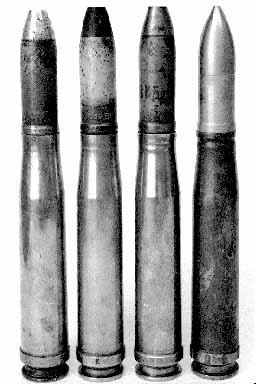
GOW archive photo: A selection of 20 x 138 Solothurn Long cartridges.
"Verily I say unto you: No prophet is accepted in his own country."/ NEMO
PROPHETA IN PATRIA! St. Luke 4: 24.
2802 MMI; PT
Less known pages of history:
Concept and birth of the Soviet PPS submachine gun
Lieutenant I.K. Bezruchko-Vysotsky was one among about 20 designers, who started
development of a new submachine gun early in 1942, when the Head Artillery Department of
the Red Army announced a contest for this kind of a gun. At the second stage of this
competition only 7 models left, including this one of Bezruchko-Vysotsky. Finally 2 models
were selected for finishing: PPD-42 by Degtyarev and M1 by Bezruchko-Vysotsky.
But at the same time A.I. Sudaev, Military Engineer of the 3rd rank, received an
order to start development of his own submachine gun. He really used the general layout
and many the most succesfull units from B-V M1 and from that time one two main competitors
were Bezruchko-Vysotsky and Sudaev.
They both made some improvements in their guns, but the results of final firing practice (
3rd round of trials) were in favour of Sudaev, his submachine gun proved to be more
reliable, as M1 by Bezruchko-Vysotsky had some functional problems ( extraction of spent
cartridges was too tight). That's why PPS (Pistolet-Pulemet Sudaeva) was put into
service, first PPS-42, then PPS-43. As for Lieutenant Bezruchko-Vysotsky, he received
Order of the Red Banner for his contribution into development of a new submachine gun. So,
for that period of time everything was more or less OK with him, which was proved by high
military award. But his later destiny is unknown to me.
Alexei I. Sudaev, as you probably know. died in 1946, at the age of only 34, his
submachine gun outlived it's creator. *)PPS-43 was converted not only into KP M/1944, but
later on produced in Spain DUX-53 and DUX-59 (full copies of Suomi M 1944) were used for
many years by West German Border Guards and Police.
Sergei (Colonel; retired), Russia
Comments: Again many thanks to Sergei for valuable information with just
one slight correction: TIKKAKOSKI's considerably redesigned copy of PPS 42/43 was no more SUOMI Gun but simply KP Model -44, or a "Sheet Henry"/
"Pelti-Heikki" in unofficial Finnish nomenclature. Main stockholder of
Tikkakoski Oy, WILLI DAUGS, was a citizen of Germany. He fled from Finland in the
autumn 1944, first to Sweden and then to Spain. (Finland and Germany were co-belligerents
since 1941 until September 19th 1944. Former friends became enemies almost overnight).
Willi Daugs possessed all the drawings of KP -44 and it's production line, presumably
micro-filmed. So it was easy to reconstruct a production line of guns in Spain. The
trademark "DUX" is derivation from name DAUGS.
West-German variation DUX-59 was designed further by engineers of Anschütz firearms
manufacture. Many original ideas of I.K. Bezruchko-Vyisotsky, Alexei Ivanovich Sudayev and
Tikkakoski Oy's designers were lost in Germany. DUX-59 was no more fit for inexpensive
mass-production and the magazine-well was no more fit to accept all kinds of Suomi
magazines (including 70 rds drums), but slightly arched Anschütz staggered-row magazines
only. According to IAN V. HOGG: "Willi Daugs left Germany and withdrew the licensing
rights from Anschütz". He vanished to South America. His later destiny is also
unknown to everybody.
*) According to JAROSLAV LUGS, Czechian author of a book "HANDFEUERWAFFEN", the
firearms designer ALEXEI IVANOVICH SUDAYEV was born in August 1912 as a son of a telegraph
mechanician in Alatyr. He passed away in August 18th 1946. J. LUGS do not mention
lieutenant I.K. BEZRUCHKO-VYISOTSKY at all on his book.
PS. My way to write Russian names and other words is "phonetic" or based on the
way how the words are pronounced. Therefore I wrote "Vyisotsky" and
"Sudayev" contrary to usual transcription from Russian to English. In Finnish I
write those names as "Vjisotski" and "Sudajev", also phonetically.
2102 MMI; PT
Suppressed Nagant once
again
Dear PT, I read with interest the letter from Colonel Sergey on my Nagant
article. His suggestion of a Third Reich connection makes a lot of sense. I knew that
the Nazis commonly used captured arms and equipment, this is one I never heard about. Do
you know if it was their practice to deface the national/arsenal marking on the weapons
before using them? Perhaps he could share his information with us, since the book he
mentioned is unavailable in the West (as far as I know). The only other silenced Nagant
I've seen is the drawing in Huebner's book. The silenced Nagant would still be an
excellent weapon even at the turn of the century. It is superior to the Welrod, using a
heavier bullet with a faster rate of fire.
Best regards, Dave
Those special
purpose firearms designed and made by Arms Academy of SS-troops were intented for most
"dirty" clandestine operations. Therefore it was needed to puncture the serial
numbers over. (Grinding them away is not a sure method). There were also never German
stamps, like proof marks or "WaA" (Heeres Waffen Amt) stamp with an eagle over a
swastika on these firearms. In general: Anything pointing to German origin of them was
absent.
Use of Russian Nagant was a very clever way of misleading: If somebody was shot with a
Nagant revolver, the Soviet agents (not German spys) were suspected. German agents had
suppressed CZ vzor 27 pistols issued for usual clandestine operations. They were made in
Bohemian-Moravian Protectorate by Ceska Zbrojovka, bearing normal stampings, usually
"fnh". Nagants were intented for some VERY special missions, presumably in
neutral countries. I don't know, whether they were ever actually used.
The Soviet-made muzzle-can type suppressor for Nagant is also mentioned on Russian
periodical magazine "Technics for the Youth" some years ago. (I have no more
this very issue of that magazine in my possession. So I am unable to recall Russian name
of it). Text of it is in Russian. Drawing of bayonet-mounted Nagant suppressor on it is
similar to that published on HUEBNER's book, but the spacers between nine rubber
wipes/baffles were drawn more circumstantially on the Russian colored illustration, than
those on a book "SILENCERS FOR HAND FIREARMS" by Siegfried F. Huebner (fig. 20e
on page 51).
2702 MMI; PT
Suppressor for Spectre
Dear PeTe, do you have a detailed drawing of a Suppressor or Silencer for the Spectre 9mm
SMG (manufactured by SITES/Italy)? Is there any possibility for foreigners to buy
Suppressors in a shop in Finland while in holiday, since in Switzerland it's nearly
impossible to buy them from official Gun Dealers.
Sincerely yours; Chris, Switzerland.
ANYBODY
is able to buy a suppressor in Finland, but I don't know whether our manufacturers have
designed mounts for SPECTRE SMG. (This very gun is almost unknown in Finland). Designers
of BR-TUOTE or ASE-UTRA can easily construct an exclusive suppressor mount for Spectre, if
they'll get information about dimensions of it's muzzle end. Both of these suppressor
manufactures lies in Joensuu; eastern Finland. (More eastern than Istambul in Turkey).
Joensuu is also my home town. Welcome to holiday in next summer!
You may also ask your official Gun Dealer whether he/she is inclined to import Finnish
suppressors from BR-TUOTE for wholesale distribution. It
shall be a profitable business in Switzerland, where domestic production of these devices
is almost nil, but there are not legal restrictions against private possession of
suppressors/silencers for firearms; as far as I know.
2802 MMI; PT
Support from America
Hi I'm interested in helping out, $10 is quite minimal and I appreciate your efforts. Is
it sensible to send a check, or should I send cash? One method of payment/money exchanging
becoming popular across the Internet is something called "Pay-Pal" where a
credit-card can be used safely - they extract a fee but it doesn't seem too bad and this
method might help others to be able to do more support.
Good luck and keep up the good work! Keith.
No other
means but cash seems to arrive to us from countries other than Finland. No checks, please!
Exchance of $ 10 check pays to us expenditures equalling $ 12:00. "Pay-Pal" does
not presumably work, since our bank account is the cheapest one, without any kind of
international credit-card connections. I presume, it is possible to pay "Debts of
Honour" only from Finland to our "Poor Man's Account". Many Finnish patrons
of GOW prefers payments in cash to our P.O.Box: It is a most SENSIBLE, most SAFE and -
definitely - a most SURE way!
PS. Many thanks for your letter, stamped in Feb. 21th '01. It arrived today to our P.O.B.
as a confirmation to my previously mentioned "S.S.S. assertion". Postage was
mere USD 0:34 from CA, U.S.A.
2602 MMI; PT
Silencer for .222 Rem.
I want to make a silencer for a .222 Remington. Do you have a detailed drawing or do you
know where I can get one?
Thanks; Benny.
If
you're planning to make a real SILENCER for .222 you should load
cartridges generating subsonic bullet velocity. If you shall use full-power .222 Remington
ammo, name of the design is a SUPPRESSOR. Flight noise
of supersonic bullet is an unavoidable evil. Design of a suppressor and a silencer may be
similar, but if you are planning to shoot subsonic cartridges only, your silencer may be
about similar to the "sound moderator" designed for a .22 rimfire (non-Magnum)
rifle: Outer diameter ca. one inch (25 millimeters) and length of jacket tube 7 to 8
inches.
A suppressor for .222 Remington rifle, shooting full-power ammo, should be somewhat longer
and bigger in diameter, say for instance 30 mm and eight to nine inches. Suppressor is
unable to eliminate "ballistic crack" of
flying bullet. Shooting noise is about as loud as that of a report of .22 rimfire rifle
loaded with High-Velocity ammo. Muzzle report may be almost eliminated by use of
suppressor but this f**king bullet's flight noise is always present, unless bullet
velocity is reduced to level 300 meters per second average (plus 5 mps minus 10 mps). When
you'll shoot subsonic (hand)loads through a suppressor, designed for use of full-power
cartridges or loads, your apparatus plays as a silencer.
Snap of a hammer or striker may be the dominant "shooting signature". There is,
however, nothing like a "definitely silent projectile-throwing weapon" existing.
A sling or even the blowpipe generates some noise. String of a longbow twangs and the
string of a crossbow snaps giving as loud noise as a .22 LR rimfire rifle, loaded with
Standard Velocity ammo. Designs of a silencer or suppressor for .222 Remington you may
find from our title side "REFLEX SUPPRESSORS" or
from the book "SILENCER HISTORY AND PERFORMANCE" Vol. I
by ALAN C. PAULSON, published by PALADIN PRESS, also publisher of
a booklet "SILENCERS FOR HAND FIREARMS" by SIEGFRIED F. HUEBNER.
You should design your silencer or suppressor without detailed drawings, by trial &
error method, because you didn't tell to me whether you'll shoot subsonics or full-power
loads, barrel length of your .222 Remington rifle or handgun, or frankly speaking: No
needed "anamnesis" about your plan. I need exact information for exact
answers. This is my "exactitude", known by our Finnish visitors but not yet
known to GOW/Universal visitors. (Excuse my severity, but I have simply not enough time to
issue answers of questions without including "anamnesis": A medical term in
Latin, meaning "knowledge given in advance").
1802 MMI; PT
Sight of Valmet Bullpup M82
I have a question about the Valmet M82 Bullpup. I've noticed the rear sight for
this rifle does not line up with the front sight and is canted to the left. I'm assuming
the front sight is view by the right eye and the rear sight matches up with the left eye.
I tried to make a simple mock up this sight and, at 30 feet, the individual points did not
match up. How does this sight work and how accurate is it?
Avery
VALMET
M82 was a notorious "design bug", developed for use of Finnish paratroopers
(Airborne Jaegers; a small elite unit) but soon rejected, because it was
ill-balanced and it's rear sight hit the front teeth of unfortunate paratroopers away from
their mouths. It was (usually) also inaccurate, because of it's offset sights, when shot
to variable ranges, although the groups were small when shot to the consistent ranges.
Frankly speaking: The Kalashnikov-based action is unfit to become a Bullpup action by
short cuts.
The only specimen I've tested was accurate. It was selected for test sometimes before the
end of it's short-lived production as a "historic curio without any future".
Manufacturer Valmet Oy Tourula Plant has been out from firearms business since
late 1980s.
1902 MMI; PT
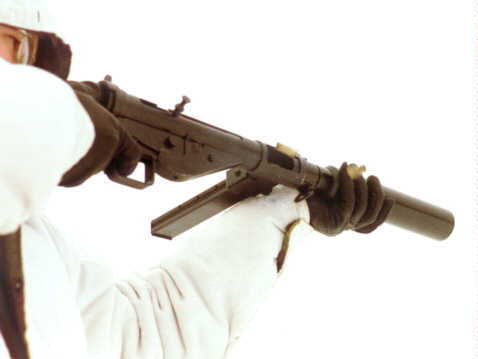 Semi-auto STEN Mark III
Semi-auto STEN Mark III
Is it possible to produce a semi-automatic Sten Mark 3? Do you know of available
information on this subject? I would like to produce a legal Sten from a parts kit.
F.M.O. III.
You
didn't mention your nationality. So I am unable to tell the legal demands of
semi-automatic firearms in your home country/ home state. STEN guns have a POSITIVE
disconnector like that of selfloading pistols. Welding of the fire selector permenently to
position "R" (= "Repetition"; semi-automatic or selfloading fire) is -
technically - a sound method to produce a STEN gun definitely unable to shoot
full-automatic fire.
Disconnector mechanism is designed to disconnect the trigger from a sear when the
breech-bolt is moving forwards and another time when the bolt is moving backwards.
Therefore the word "POSITIVE" is justified, and some more complicated mechanism
of a breech-bolt (like an independently moving striker) is unnecessary.
1402 MMI; PT
Dimensions/drawings of a BARRETT rifle
 Please
can you tell me the external dimensions of the Barrett
M82 A1 rifle? I am trying to make a 1 : 1 scale air powered replica. The dimensions I
need are as follows: barrel, muzzle
brake, main receiver, scope mount, pistol grip, butt pad, etc. Drawings with
dimensions would be gratefully appreciated.
Please
can you tell me the external dimensions of the Barrett
M82 A1 rifle? I am trying to make a 1 : 1 scale air powered replica. The dimensions I
need are as follows: barrel, muzzle
brake, main receiver, scope mount, pistol grip, butt pad, etc. Drawings with
dimensions would be gratefully appreciated.
Many thanks M.J., Coventry, England. PS: I think your website is top.
Sorry; I
have never seen Barrett M82 A1, except on the photographs, and it is presumably impossible
to get dimensional drawings of this very rifle from any other sources but from the manufacturer of original Barrett rifle, which by
our repeated experience does not bother to answer questions of unpotential customers. And
I don't know, whether this manufacturer is still active. I hope that some visitor of
GOW/Universal is able and willing to assist you. Our policy is an open interactivity.
1002 MMI; PT
Additional Information
About the suppressed Nagant
It was very interesting for me to came across the article
published by David Harber. I also study the history of Nagant revolver and such
information I see for the second time. First I had a chance to read about silenced
revolvers in "The Arms of Red Army" book by V. SHUNKOV (Minsk, 1999,
ISBN 985-433-469-4), but the story sounds a little bit different.
Germans managed to capture at the initial stage of war with the USSR large quantities of
the small arms, including Nagant revolvers. They were used by Germans under marking "Revolver
612 (r)". Some of such revolvers were converted into silenced ones at the Arms
Academy of SS Troops. Anyhow, it is very good to receive another piece of evidence about
such use of Nagant revolvers.
Regards, Sergei, Colonel (Retired), Moscow, Russia
Editors comment: Many thanks for your valuable information! As far as we
knew earlier, the Soviet suppressor for Nagant revolver "was attached firmly with a
bayonet latch to the foresight on the weapon. It holds nine rubber discs which have to be
replaced after two to twenty shots, because the weapon blast becomes louder and accuracy
deteriorates" according to Siegfried F. Huebner. I have seen a drawing of
this suppressor also on the Russian periodical magazine: "Technics for the Youth".
Do you know, whether the designer of a "chamber suppressor" Colonel HUMBERT (Gumbert)
was a citizen of Imperial Russia? He was unable to get his invention protected by the
patent anywhere, and just the Czarist Russia was a country without a patent legislature in
the late 1890s. Just the Finnish literature and magazine "Technics for the
Youth" are mentioned name of Colonel Humbert. Finnish source of information, a
periodical magazine "The Science And Life" published by it's chief
editor INTO KONRAD INHA, was printed in 1921.
Another question: Do you know destiny of Lieutenant BESRUSZKO- VYISOCHKY, a resident of
Leningrad during the siege? Was he the actual designer of a submachine gun known as Pistolyet
Pulemyot Sudayeva (PPS), or "the very best invention discovered during the Great
Patriotic War in Soviet Union" according to Mikhail Timofeyevich Kalashnikov
? In 1944 Finnish designers of Tikkakoski Oy made some improvements to PPS
submachine gun, like a magazine-well accepting all types of SUOMI
submachine gun magazines, including 70 rds drum, and adoptment of caliber 9 x 19 mm.
According to my shooting experience, this Finnish copy of PPS is a very pleasant gun to
shoot. Just a rare VOERE AMERICAN 180 submachine gun has been more easy to control when
shooting full-automatic fire, but it's caliber is .22 Long Rifle.
0602 MMI; P.T.Kekkonen, Chief Editor of GOW/Universal
More about TOZ rifle
Thanks for your quick reply. I have chambered the Ten X rounds as well as many other
brands of .22 LR 40 grain ammo and in all cases the rifling marks come up to the second
band on the bullet... and yes, the lands are wider than the grooves. Something else is a
bit odd with my barrel.. the bore is not central (.02") with the external diameter...
I discovered this when I cut 75 mm from the barrel (now 22") in the lathe and was
about to crown the end... I ended up crowning it with a fine 12mm spherical Drammel
mounted stone in my battery drill... slow revs, forward and reverse until satisfied with
the results... 15 mm groups at 50 M on a good day.
Question: Will the eccentric bore effect any suppressor which I may decide to mount later
(when suppressors become legal here - of course)?
Regards, Peter
It is
rather a rule than an exception that TOZ barrels have somewhat crooked bore. Fortunately
enough, the Russians knows that a crooked bore shoots as well as straight one. In Finland
was an unpleasant practice to straighten the bores by bending of the barrel blanks. With
this crude method there were made thousands and another thousands of rifles producing a
"walking group" syndrome. Id est: When the barrel is warming up by
shooting, it's material "recalls" original un-bend structure of barrel walls and
it starts to be bendind, making the bore to become crooked again as long as the barrel is
warm or hot.
Barrel of your TOZ shall presumably shoot small groups when cool or hot. You should mount
the suppressor with extra care. It is advisable to remove barrel of your TOZ rifle from
it's action and mount it into the three-jaw chuck of the lathe-bed, around the rebated
rear end of a barrel. The front end of a bore must be centered to the conical spindle or
apice of a lathe. So it is possible to turn the thread for suppressor mounting concentric
and coaxial enough with the bore. A well-designed suppressor shall not deteriorate
accuracy of your rifle if it is mounted along with the bore, and not along with the
eccentric outer diameter of barrel.
1002 MMI; PT
Sidearms of Legionnaires
Do you know what kind of handguns that the French Foreign Legion carried in the 1920's in
North Africa? I would really appreciate some help on this one!
Thanks, Andria, Dallas Theater Center/Props
Usually 8 mm
"LEBEL" revolvers Modèle d'Ordonnance (vintage 1892) but after the
First World War a wide selection of selfloader pistols bought from Spain; so called
"RUBY" pistols, caliber .32 ACP (at least 50 trade marks) and Spanish
"STAR" pistols, caliber also .32 ACP. There were at least 0.7 million of
Spanish-made pistols bought from Spain during WWI plus 27 500 US-made SAVAGE Model 1917
.32 ACP pistols from USA until the end of that Big War.
I presume, those 8 mm revolvers were most common issue for the Foreign Legion, but any
kind of those pistols mentioned above might be met in North Africa as a weaponry of
Legionnaires in 1920s.
1002 MMI; PT
Book about "The White Death" in English?
I see your response about book about Simo Hayha. If you should
even hear of it being translated to American English please do your best to let the world
know. I had the honor of meeting Mr Hayha September last and it was a moving expierence.
One I will remember all my life. http://albums.photopoint.com/j/ViewPhoto?u=196242&a=9545595&p=31414118
There are other photos there if you'd like to see them. Do you know my friend M. R. there
in Joensuu?
Michael, New Mexico, USA
I know M. R.
very well. He is a secretary of an Arms History Guild of North Carelia. I am a Founder
Member of this Guild, but I have no more time to take part of Guild meetigs since February
1999, when I became a Special Editor and, since 6th December 2000, a Chief Editor of GOW
sites.
There are not (yet) books about SIMO HAYHA published in English. We are presumably lacking
translators able to master firearms technical English and military vocabulary.
05 02 MMI; PT
Arcane
I was very pleased to find your Arcane information. Some of it
is what I tried 20 years ago to shoot on 25 meter ranges. I used Red Dot and similar
charges to my .357 pistol loads. This was before our fucking (RED) government took our
pistols and revolvers from us.
I have once again started to make low power loads in 7.62 NATO and .303 British. To avoid
the problems with very small charges 3 grains or less in rifle cases I have filled them
with car body filler! Then I drilled out the neck to about the volume of a 32 Smith &
Wesson Long case and through the flash hole with a small drill. With 2.5 to 3 grains these
shoot 25 mm or less sized groups. I have shot 25 reloads and the cases are still going
strong. I tried the above by casting lead in to the cases. It works well but the cartriges
are HEAVY. I hope this is of interest to you and my give outhers some ideas
Yours R E G
Comment: Some
Finns are also tried case lining trick successfully. One friend of mine lined cases of his
.458 Winchester Magnum rifle cartridges with stumps of of plastic (soft PVC) hose for
reduced charge loads ca. 20 years ago. I presume, he has those cases still in use. (I've
lost his phone number. So I cannot ask). For necked cases like those of 7.62 NATO and .303
the "definitive solution" is a factory-made compression moulded plastic liner,
installed to the case before necking. Unfortunately the cartridge manufactures hate my
idea about "everlasting cases" and use of reduced charges at all. Your method is
O.K. In Finland is the plastic material SIKAFLEX tried for similar purpose. I don't know
composition of this filler plastic. So I am unable to predict, how long-lasting it is in
this special purpose especially in cold weather.
For the factory-made liners may polyethene or polypropylene polymer be ideal material,
because those plastics are somewhat elastic. Liner must be tightly fitting into the case
and allow some expansion and shrinkage of the brass case. In Germany are available special
cases for reduced charge loads similar to old Everlasting cases but with considerably
reduced powder spaces. They are lathe-turned from a brass bar-stock, being heavy and
expensive. Your lead-lined cases are somewhat heavier but considerably less expensive.
Promising castable lining materials are also alloys of aluminium and magnesium.
0302 MMI; PT
Tried tricks:
Rifling twist of TOZ
Hi Pete, To determine the twist rate of my TOZ 8, I used my cleaning rod which has a
rotating knob on the end. I attached a nylon brush to the jag end and inserted it all the
way down the barrel. I marked the top of the rod with a marking pen, then pulled the rod
out until the mark completed one full revolution then measured the distance between the
mark and the end of the barrel....Walla!! 1 in 14" twist.
Attached is a picture of my TOZ 8 after a few mods. I have fitted a 3 - 9 x 40 mm Hakko
since this photo was taken. It shoots well with cheap Winchester ammo 1150 fps. 15 mm
groups at 50 m are common with the odd flyer. It hates TeneX and will only hold a 50 mm
group. I am still experimenting with ammo to find the most suitable. I like your web
page....full of great information.
Best regards, Peter, Adelaide, Australia.
and comment:
Our ballistician Markus determined twist of his 40 years old TOZ rifle by similar method,
using brass brush. It was 1 in 14". We didn't first believe on this reading, because
TOZ is able to gyro-stabilize positively bullet of Aguila .22 SSS cartridge. There is,
however, another stabilizing factor in the TOZ bore: Very short "leade" or
"throat" between the chamber and rifled bore. When the bolt is closed, a shank
of bullet enters rifling slowly and gently. Bullet is concentrated into the bore manually
before shot. Not after the shot by the force of powder gasses, sometimes after a
"free flight" through a throat of chamber. Another dark secrecy of accuracy are
dimensions of rifling. Diameters are as usual, bore dia. 5.5 mm, groove diameter 5.7 mm...
BUT: The lands of rifling are broad and four grooves of TOZ bore are narrow.
Excessively long .22 SSS bullet may become gyro-stabilized even by 1 in 14" rifling
of TOZ, because it is concentric and coaxial to the bore before shooting and the bore is
keeping it in a tight embrace. TeneX bullet has presumably too long point. Shank or body
of it shall presumably not reach the rifling lands before shooting. There is an easy trick
to determine, whether or not some cartridge is potentially accurate in TOZ rifle: Chamber
the cartridge and close the bolt. Open the bolt again and examine ejected cartridge. If
there are visible rifling marks engraved on the bullet, the cartridge is potentially
accurate in TOZ.
Russian .22 LR cartridges had a rather thick and messy dip lube on their bullets. Despite
of cheap price they were accurate in TOZ rifles. Many autoloader firearms hated them, of
course, because the accumulation of fouling, but for them there were available other
brands of cartridges. Have you tried dip lubrication of TeneX bullets? This simple trick
may improve accuracy of them in TOZ. A tried lubricant is molten mixture of bovine or
mutton tallow (70 to 75%) and white candle stearine (25 to 30%). You may dip 50 bullets at
a time. Keep them immersed to the hot lube 15...20 seconds, then let them cool slowly.
0402 MMI; PT
How to cook "the soup" - and survive?
First of all I have to say that you have a very nice web site. Second, I would like to ask
you the exact formula on making nitroglycerin, and if it is possible the way of
introducing a substance in the place of explosion because of the extremely unstable nature
of it.
Thanks: AM
Nitroglycerin unstable? "Wahoo!" There is a small sample of "soup",
made by it's inventor SOBRERO in 1847, still left in Italy. (Stuff is pure). Unstable
nitroglycerin contain usually remnants of acids or other impurities. It may start
spontaneous decomposition soon after it's production, especially in warm conditions.
Production process is as follows: Mix first an acid mixture, containing 300 grams of
strong (fuming) nitric acid and 500 grams of strong (fuming) sulphuric acid in some
acid-proof vessel. Let the nitrification acid mixture cool to temperature +15 degrees
Celsius/Centigrade. A centigrade thermometer is ESSENTIAL instrument for producer of
"soup"!! A glass jar is good nitrification vessel. Put it into a tub partially
filled with cold water and keep some ice cubes easily obtainable.
Stir the acid mixture with a PE plastic ladle, making a rapid whirlpool. Pour 25 grams of
pure glycerin SLOWLY into the whirling nitrification acid close to the edge of
nitrification vessel. Dropping the glycerin (drop by drop) is unnecessary, but flowing of
glycerin must be slow. Measure temperature of acid mixture after each addition ca. 25
grams of glycerine. If it is more than + 20 degr. C, drop some ice cubes into the water,
surrounding nitrification vessel. (In the names of all the Saints and Demons: DO NOT THROW
THEM INTO THE ACID!!!). Wait, still stirring the acid, until temperature is again +15
degrees Centigrade. Add some more ice into surrounding water if needed. Then add another
25 grams or an ounce of glycerine slowly to the acid mixture whirlpool and measure again
temperature. Add the ice cubes into surrounding water if necessary, et cetera.. Total
quantity of glycerin is 100 grams for 800 grams of acid mixture. Yield is ca. 220 grams of
nitroglycerin.
A critical temperature is +30 degr. C. If you are approaching it, my advice is: "RUN
SWIFTLY! Say your prayer later..!" Or keep a big tub almost full of cold water
adjacent the nitrification vessel. If the thermometer shows a temperature of acid +
glycerine mixture ca. +28 degr. C and the red fume starts to rise from vessel, pour the
mixture into the water tub. DO NOT throw water into the mixture!!! (This is one of THE
GOLDEN RULES of Chemistry). This large tub or vat of water is always present in factories,
producing nitroglycerin. It is known in Finland as "A Safety Tub". It's volume
must be at least ten times a volume of acid & glycerine mixture and it must contain
cold water at least 8 times the volume of mixture 800 grams acids and 100 grams glycerin.
When the last 25 grams of glycerin is added into acid mixture, being alert that
temperature of "the soup" shall not rise above safe limit, you have 215 to 220
grams of nitroglycerin floating on the surface of an acid remainders. Stop the stirring
and wait at least six hours. You must now "skim" the nitroglycerin from acid
remnants. Scoop 135 cubic centimeters of "cream" from the vessel. It is ALMOST
pure nitroglycerin, but "almost" is not yet pure ENOUGH to be stable 154 years'
period. Add 30 cubic centimeters of water into the NG, stir very gently and filtrate the
product through a mixture of 50% sodium bicarbonate and 50% of common cook salt (sodiun
chloride). If there are acid remnants still in the soup, repeat the "washing"
and filtration. So easy/ difficult is safe yielding of nitroglycerin.
I envy the lucky Americans, who have almost pure ammonium nitrate available in each store
selling fertilizers. Mixture of ammonium nitrate (Finnish code-name: "Anitra")
and Diesel oil (Finnish code-name: "Antero") is able to make more destruction
than nitrolycerine, which does only a hole on the floor and breaks windows. Heavy charge
of "Antero" is able to "huff and puff", lifting the roof of a big
house sky-high and collapse walls of the concrete building. Another interesting stuff is
"Candy Anitra" (in Finnish "Karkki-Anitra"): Mixture of ammonium
nitrate and pulverized sugar. These Anitra-based explosives needs rather strong priming
with a brisant booster-charge for reliable ignition and detonation. Nitroglycerin is a
very good booster explosive.
One of our Finnish visitors is planning to make solid rocket fuel from potassium nitrate
(65%) and sorbitol (35%). This mixture is easy to melt and cast into the rocket motor. I
don't know yet, whether it is possible to produce detonation of solid saltpeter &
sorbitol mixture with strong priming and booster charge. Anitra & sorbitol mixture may
also be possible to melt and so get a solid explosive without decomposition of Anitra,
which yields nitrous oxidule i.e. the laughing gas.
Source of information: Book "TAVARASANAKIRJA"/ "DICTIONARY ON
MERCHANDISE", 2nd edition, published in 1947. Text in Finnish.Cooling method of
nitroglycerin is simplified. "Tavarasanakirja" presents method of large-scale
nitrogycerin production. Small quantity (220 grams) needs no expensive cooling
arrangements like blowing of cold compressed air through acid & glycerin mixture.
Temperature control of exothermic nitrification process is, however, essential.
0402 MMI; PT
.22 Remington Auto cartridges
I am trying to find ammo for a Remington .22 Model 16 auto load. Could you please send me
any information you may have on where I might be able to get ammo for this gun?
Thank you; Johnny
Remington
Model 16 Autoloading rifle was introduced in 1914. Production was discontinued in 1928.
Loading of .22 Rem. Auto cartridges was discontinued 55+ years ago. Cartridges are
impossible to get anywhere. Winchester designed earlier about similar .22 Winchester
Automatic cartridges for their Model 1903 rifles (discontinued in early 1930s). Remington
and Winchester cartridges were/are not interchangeable. .22 Win. Auto cartridges were
loaded until late 1970s, if not still later - funny enough - by Remington.
Idea of these rifles and special-sized cartridges was to prevent use of .22 Long Rifle
cartridges in autoloading rifles, since LRs could be loaded with blackpowder or
semi-smokeless propellants. Copper cases were common in .22 LRs and bullets were
outside-lubricated with thick messy mixtures of tallow, beeswax and Valvolin Cylinder Oil.
Cartridges for autoloader rifles had diameter of their brass cases big enough to allow
"inside lubrication" of bullets, because a shank (body) of bullet - no more only
a rebated "heel" of it - went into the case mouth. Bullet's visible point was no
more lubricated. "Lube grooves" or "cannelures" filled with wax
mixture were entirely hidden inside the case mouth.
This trick was actually adopted in 1890 for .22 Winchester Rimfire (WRF) cartridges,
designed for Winchester Model 1890 pump-repeater rifles. "Messy lube" on the
bullets was found to be a problem when shooting even the manually loaded magazine rifles.
A variation of .22 WRF is still among us as a .22 Winchester Magnum Rimfire cartridge,
with jacketed bullets and lengthened case. Diameter of case and rim dimensions of old WRF
and modern smokeless WMR are similar. It is possible to shoot old blackpowder WRF
cartridges from rifles chambered for WMR ammo. Shame and scandal is that .22 WRF has been
discontinued. A .22 Win. Magnum rifle is lacking versatility: Nothing but rather noisy
full-power loads are available for it, while WRF cartridge may be loaded even to subsonic
noise level, because of it's slippery lead bullet weighing 45 grains and having a flat
point. It was a fine game-getter.
The same bullet weight 45 grains was also chosen for both of these .22 Autoloader rimfire
cartridges. Case/chamber length of autoloaders was shorter than those of .22 WRF, because
smokeless load of Autoloader ammo needed less space and it was also needed to prevent
shooting of .22 WRF ammo (still loaded with black or "Lesmoke" powder) from
autoloader rifles, designed during "transitional era". When the smokeless powder
became a dominant propellant of .22 LR ammo, along with brass cases and less thick bullet
lubricants, the era of transition was over. In 1920s there were invented "dry
wax" lubricant and even the metal coatings ("Lubaloy" or cadmium
electroplating) for .22 Long Rifle bullets. So the firearms manufactures chambered
autoloader rifles also for .22 LRs, and later these rifles are chambered for Long Rifle
ammo only.
I presume that ammo manufactures shall never more load cartridges for Remington Model 16.
They are hesitant to start loading of some sought-after cartridges even for .22 LR. One
example is .22 Autoloading Subsonic ammo with "intermediate length" case and
bullet weight 50 grains, fit for any and all autoloader firearms chambered for .22 LR.
There were no other rifles but Remington Model 16 chambered to shoot .22 Rem. Automatic
cartridges. During 14 years of manufacturing, there were made definitely not enough rifles
for re-introduction of it's cartridges. I don't know, whether it is possible to re-barrel
Model 16 for shooting of .22 LR ammo. If it is, there are presumably not many Model 16s
existing in original chambering, and the worth of your rifle as a collector's item is
increasing accordingly.
0202 MMI; PT
More >>
<< New Q&A More Q&A, part 10 >> Part 9
>> Part 8 >> Part 7 >> Part 6 >>
Part 5 >> Part 4
>> Part 2 >> Part
1 >> Gunwriters guns.connect.fi Link page